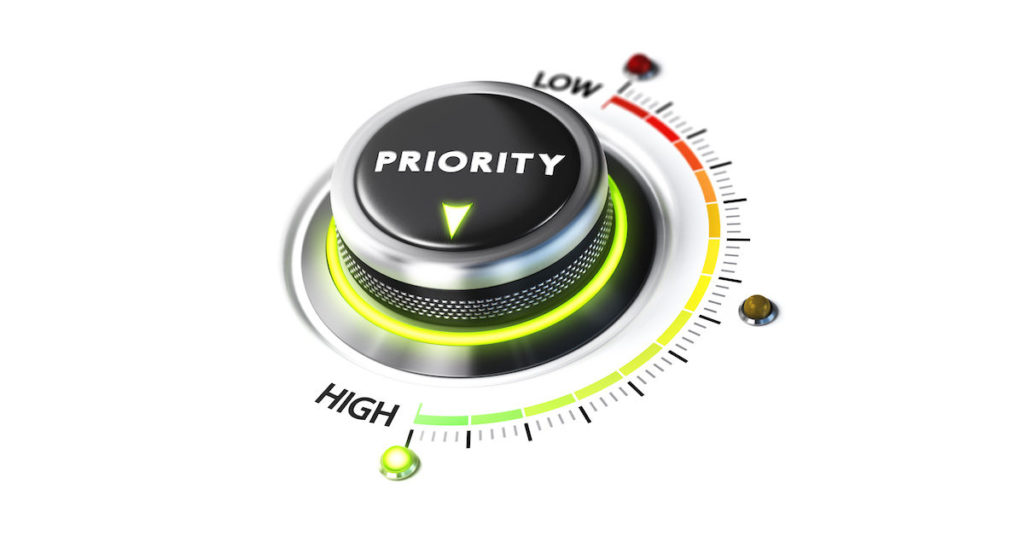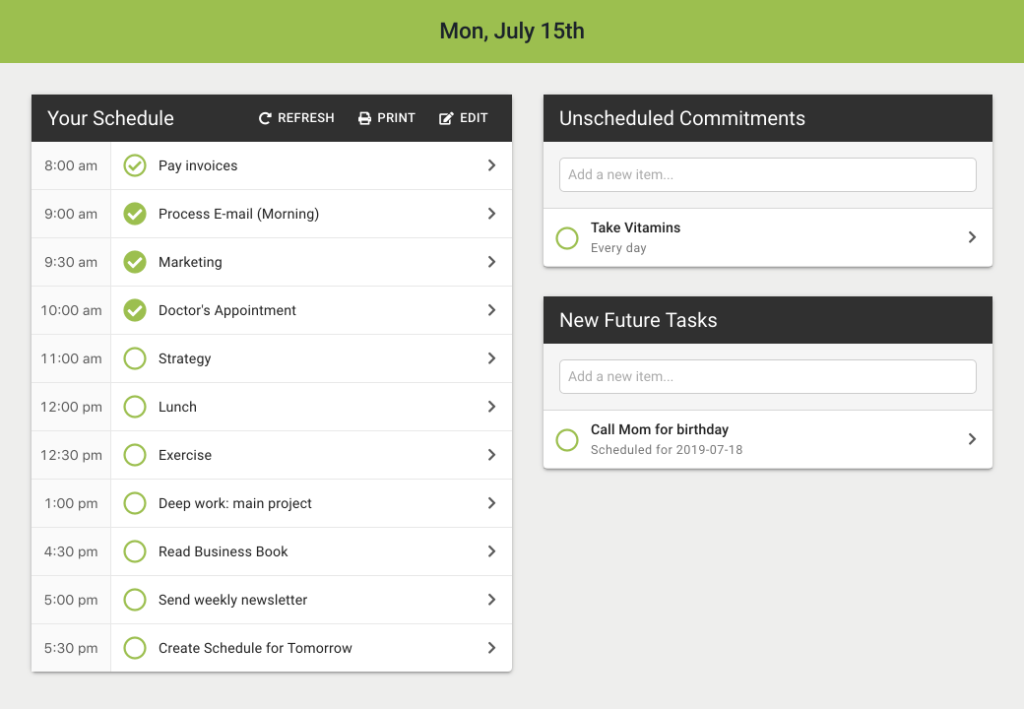Key to good time management is prioritizing what needs to be done when.
Today we’re going to discuss seven techniques for helping you decide your priorities and what to do first.
1. Divide & Conquer
When you have a long list of things, it can be hard to figure out what is most important, especially when many items seem to have the same priority.
Part of the problem is that priorities are always relative, and we don’t really know what the priority of an item is until we compare it to other items (your house being on fire is your highest priority…unless you’re having a heart attack).
To prioritize more effectively, it helps to break long lists into shorter lists. This allows us to leverage our working memory to compare and prioritize items against each other.
An effective technique is to divide your list into two sub-lists: Higher & Lower.
Look at each item on your list and place it into one of these two sub-lists. If you’re spending too much time deciding where some items go, create a third list called In Between to contain these.
Divide & Conquer Again
If you have too many items in a sub-list, you can repeat the process to further refine your priorities.
For instance, repeat the process with just the items in your Higher list, and then again with just the items in your Lower list. You’ll wind up with four lists: High Higher, Low Higher, High Lower and Low Lower.
Keep dividing and conquering until you have a manageable number of items in each list.
If you’re dividing into groups of 3, try using the labels High, Medium, Low for your first round, then High-High, Medium-High, Low-High, High-Medium and so on, for your second round, giving you 9 levels of priorities in total.
2. This Or That
What if you have a short list of items, but don’t know where to start?
Take two items from your list and pretend that you can only do one of those items. Which one is it: this one or that one?
The one you pick is the winner. Now take another item from the list and ask the question again, comparing the previous winner with the new item. Repeat until you have the final winner, which should be your highest priority.
The key to making this work is that you really do need to pick just one. You can’t hedge and say you’ll do them both. So what if you can’t decide which one?
Can’t Decide? Flip a Coin
Flip a coin. No, seriously. Go grab a coin from your wallet and flip it. If your choices are truly the same priority, it doesn’t matter which one you pick as the winner.
However, the process of flipping the coin often surfaces hidden drivers of which one is more important. If you find yourself resisting the result of the coin toss, ask yourself why. The coin toss often acts as a forcing function that helps you decide for yourself which one is most important.
Similarly, if you go through this exercise and end up with a winner that doesn’t feel right, that’s information you can use to determine the real priorities.
Sometimes the exercise helps you set your priorities, other times it helps you identify those priorities yourself by surfacing feelings or reasons you didn’t know you had.
3. Open Doors & Rocket Boosters
You’ll often hear advice to focus on your most important tasks. But what makes a task important?
Ask yourself how it impacts your situation or your self.
Your situation is where you are and the opportunities available to you. Does the task move you forward or open new doors for you? (Or prevent you from backsliding or having doors close on you?)
Your self includes your abilities and energy to accomplish your goals. Does the task boost your abilities or energy? (Or prevent them from being drained?)
If this is a task for your boss or your company, ask yourself how it impacts them, and then through them, how that impacts you.
There’s no simple formula for what makes a task important. But by asking these questions, you can gain a better understanding of your own personal drivers of importance.
4. Velocity & Drag
Always focusing on your highest priorities can sometimes slow you down.
Think about all the little annoyances in your life that are low priority, but slow you down, distract you or drain a little bit of your energy. Things like the burnt out lightbulb in your staircase, or not having a place to put your keys when you get home.
Each of these on their own isn’t worth addressing; they’re minor annoyances. But when taken together, they can create significant drag on your day-to-day activities.
Your Eliminate Drag List
Stop thinking of these as individual items when prioritizing your to-dos. Instead, group them together into an “Eliminate Drag” task, then prioritize that.
Likewise, ask yourself what you can do to amplify your effectiveness? Maybe that’s scheduling a time each week to stop doing and plan. Or reviewing your notes to extract key insights from a meeting or workshop you attended.
Your Increase Velocity List
Batch these tasks together into an “Increase Velocity” task, and prioritize that.
By grouping small things together, and prioritizing them as a group, you can set aside time for important, but not urgent tasks that can have a great impact on your life.
To make this into a practice, set aside one day a month as your “Tune-Up Day”, where you do all those minor tasks that help you eliminate drag and increase your velocity. You’ll soon see yourself being more effective with your main priorities.
5. Least Important First
Sometimes it can be hard to figure out what your highest priority is. When this happens, instead of trying to decide what’s most important, decide what’s least important.
The change in perspective can help break log jams in your thinking. Deciding what isn’t important can also give you insight into what is important.
Eliminating items from your list helps reduce your mental overhead and increases focus when comparing your remaining to-dos.
When you have only 3 items, there are only 6 potential ways to order those items. But each additional item increases the number of combinations dramatically. There are 120 different ways to order 5 items and over 3 million ways to order 10 items.
One of the easiest ways to reduce the number of tasks you are prioritizing is to remove the low priority ones; they’re often easy to identify and require less analysis, since less is at stake.
6. Move Two Squares Forward
When evaluating a task, ask yourself where does this task bring you on the game board of life. What impact does it have on your long-term goals and what opportunities does it open up?
A simple technique is to evaluate your tasks on a 5-point scale:
- No Impact
- Small Indirect Impact
- Small Direct Impact
- Large Indirect Impact
- Large Direct Impact
A direct impact would be something that moves you closer to your long-term goals. An indirect impact would be something that helps make that movement easier, by removing barriers or preparing you for success.
7. If Not This, Then That
What are the real consequences of you not doing a task?
The best way to make time for your priorities is to eliminate those things you don’t need to do at all.
Instead of thinking about the impact of doing a task, thing about the impact of not doing the task. If the task didn’t get done, what else would you do? What would the consequences be?
Often the consequences of not doing a task aren’t as severe as we think. We each play the lead role in our own play, so it feels like everything we do is important. But frequently, that’s not the case—and when it is, by defining the consequences, we help clarify the importance of that task.
If you found these techniques useful, have any questions, or have specific topics around time management you’d like addressed, leave a comment below.








